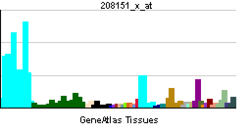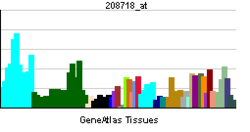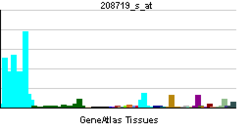- DDX17
-
DEAD (Asp-Glu-Ala-Asp) box polypeptide 17 Identifiers Symbols DDX17; DKFZp761H2016; P72; RH70 External IDs OMIM: 608469 MGI: 1914290 HomoloGene: 101101 GeneCards: DDX17 Gene EC number 3.6.4.13 Gene Ontology Molecular function • nucleotide binding
• RNA binding
• RNA helicase activity
• ATP binding
• ATP-dependent helicase activity
• RNA-dependent ATPase activity
• hydrolase activityCellular component • nucleus Biological process • RNA processing Sources: Amigo / QuickGO RNA expression pattern 


More reference expression data Orthologs Species Human Mouse Entrez 10521 67040 Ensembl ENSG00000100201 ENSMUSG00000055065 UniProt Q92841 Q3TU25 RefSeq (mRNA) NM_001098504.1 NM_001040187 RefSeq (protein) NP_001091974.1 NP_001035277 Location (UCSC) Chr 22:
38.88 – 38.9 MbChr 15:
79.36 – 79.38 MbPubMed search [1] [2] Probable ATP-dependent RNA helicase DDX17 (p72) is an enzyme that in humans is encoded by the DDX17 gene.[1][2]
DEAD box proteins, characterized by the conserved motif Asp-Glu-Ala-Asp (DEAD), are putative RNA helicases. They are implicated in a number of cellular processes involving alteration of RNA secondary structure such as translation initiation, nuclear and mitochondrial splicing, and ribosome and spliceosome assembly. Based on their distribution patterns, some members of this family are believed to be involved in embryogenesis, spermatogenesis, and cellular growth and division. This gene encodes a DEAD box protein, which is an ATPase activated by a variety of RNA species but not by dsDNA. This protein and that encoded by DDX5 gene are more closely related to each other than to any other member of the DEAD box family. Alternative splicing of this gene generates 2 transcript variants encoding different isoforms with the longer transcript reported to also initiate translation at a non-AUG (CUG) start site.[2]
Interactions
DDX17 has been shown to interact with HDAC1,[3] Nuclear receptor coactivator 1,[4] Nuclear receptor coactivator 3,[4] Estrogen receptor alpha,[4] Nuclear receptor coactivator 2, [4] SRA1,[4], DDX5 (p68)[5] and DHX9 (RNA Helicase A)[6]
References
- ^ Lamm GM, Nicol SM, Fuller-Pace FV, Lamond AI (Dec 1996). "p72: a human nuclear DEAD box protein highly related to p68". Nucleic Acids Res 24 (19): 3739–47. doi:10.1093/nar/24.19.3739. PMC 146168. PMID 8871553. http://www.pubmedcentral.nih.gov/articlerender.fcgi?tool=pmcentrez&artid=146168.
- ^ a b "Entrez Gene: DDX17 DEAD (Asp-Glu-Ala-Asp) box polypeptide 17". http://www.ncbi.nlm.nih.gov/sites/entrez?Db=gene&Cmd=ShowDetailView&TermToSearch=10521.
- ^ Wilson, Brian J; Bates Gaynor J, Nicol Samantha M, Gregory David J, Perkins Neil D, Fuller-Pace Frances V (Aug. 2004). "The p68 and p72 DEAD box RNA helicases interact with HDAC1 and repress transcription in a promoter-specific manner". BMC Mol. Biol. (England) 5: 11. doi:10.1186/1471-2199-5-11. PMC 514542. PMID 15298701. http://www.pubmedcentral.nih.gov/articlerender.fcgi?tool=pmcentrez&artid=514542.
- ^ a b c d e Watanabe, M; Yanagisawa J, Kitagawa H, Takeyama K, Ogawa S, Arao Y, Suzawa M, Kobayashi Y, Yano T, Yoshikawa H, Masuhiro Y, Kato S (Mar. 2001). "A subfamily of RNA-binding DEAD-box proteins acts as an estrogen receptor α coactivator through the N-terminal activation domain (AF-1) with an RNA coactivator, SRA". EMBO J. (England) 20 (6): 1341–52. doi:10.1093/emboj/20.6.1341. ISSN 0261-4189. PMC 145523. PMID 11250900. http://www.pubmedcentral.nih.gov/articlerender.fcgi?tool=pmcentrez&artid=145523.
- ^ Ogilvie VC, Wilson BJ, Nicol SM, Morrice NA, Saunders LR, Barber GN, Fuller-Pace FV. (2003). "The highly related DEAD box RNA helicases p68 and p72 exist as heterodimers in cells". Nucleic Acids Res. 31 (5): 1470–80. doi:10.1093/nar/gkg236. PMC 149829. PMID 12595555. http://nar.oxfordjournals.org/content/31/5/1470.long.
- ^ Wilson, Brian J; Giguere V (Nov. 2007). "Identification of novel pathway partners of p68 and p72 RNA helicases through Oncomine meta-analysis". BMC Genomics (England) 8: 419. doi:10.1186/1471-2164-8-419. PMID 18005418. http://www.biomedcentral.com.ezp-prod1.hul.harvard.edu/1471-2164/8/419.
Further reading
- Lüking A, Stahl U, Schmidt U (1998). "The protein family of RNA helicases". Crit. Rev. Biochem. Mol. Biol. 33 (4): 259–96. doi:10.1080/10409239891204233. PMID 9747670.
- Andersson B, Wentland MA, Ricafrente JY et al. (1996). "A "double adaptor" method for improved shotgun library construction". Anal. Biochem. 236 (1): 107–13. doi:10.1006/abio.1996.0138. PMID 8619474.
- Yu W, Andersson B, Worley KC et al. (1997). "Large-Scale Concatenation cDNA Sequencing". Genome Res. 7 (4): 353–8. doi:10.1101/gr.7.4.353. PMC 139146. PMID 9110174. http://www.pubmedcentral.nih.gov/articlerender.fcgi?tool=pmcentrez&artid=139146.
- Dunham I, Shimizu N, Roe BA et al. (1999). "The DNA sequence of human chromosome 22". Nature 402 (6761): 489–95. doi:10.1038/990031. PMID 10591208.
- Watanabe M, Yanagisawa J, Kitagawa H et al. (2001). "A subfamily of RNA-binding DEAD-box proteins acts as an estrogen receptor α coactivator through the N-terminal activation domain (AF-1) with an RNA coactivator, SRA". EMBO J. 20 (6): 1341–52. doi:10.1093/emboj/20.6.1341. PMC 145523. PMID 11250900. http://www.pubmedcentral.nih.gov/articlerender.fcgi?tool=pmcentrez&artid=145523.
- Uhlmann-Schiffler H, Rössler OG, Stahl H (2002). "The mRNA of DEAD box protein p72 is alternatively translated into an 82-kDa RNA helicase". J. Biol. Chem. 277 (2): 1066–75. doi:10.1074/jbc.M107535200. PMID 11675387.
- Hönig A, Auboeuf D, Parker MM et al. (2002). "Regulation of Alternative Splicing by the ATP-Dependent DEAD-Box RNA Helicase p72". Mol. Cell. Biol. 22 (16): 5698–707. doi:10.1128/MCB.22.16.5698-5707.2002. PMC 133985. PMID 12138182. http://www.pubmedcentral.nih.gov/articlerender.fcgi?tool=pmcentrez&artid=133985.
- Ohta S, Shiomi Y, Sugimoto K et al. (2002). "A proteomics approach to identify proliferating cell nuclear antigen (PCNA)-binding proteins in human cell lysates. Identification of the human CHL12/RFCs2-5 complex as a novel PCNA-binding protein". J. Biol. Chem. 277 (43): 40362–7. doi:10.1074/jbc.M206194200. PMID 12171929.
- Lee CG (2002). "RH70, a bidirectional RNA helicase, co-purifies with U1snRNP". J. Biol. Chem. 277 (42): 39679–83. doi:10.1074/jbc.C200337200. PMID 12193588.
- Strausberg RL, Feingold EA, Grouse LH et al. (2003). "Generation and initial analysis of more than 15,000 full-length human and mouse cDNA sequences". Proc. Natl. Acad. Sci. U.S.A. 99 (26): 16899–903. doi:10.1073/pnas.242603899. PMC 139241. PMID 12477932. http://www.pubmedcentral.nih.gov/articlerender.fcgi?tool=pmcentrez&artid=139241.
- Ogilvie VC, Wilson BJ, Nicol SM et al. (2003). "The highly related DEAD box RNA helicases p68 and p72 exist as heterodimers in cells". Nucleic Acids Res. 31 (5): 1470–80. doi:10.1093/nar/gkg236. PMC 149829. PMID 12595555. http://www.pubmedcentral.nih.gov/articlerender.fcgi?tool=pmcentrez&artid=149829.
- Fujita T, Kobayashi Y, Wada O et al. (2003). "Full activation of estrogen receptor alpha activation function-1 induces proliferation of breast cancer cells". J. Biol. Chem. 278 (29): 26704–14. doi:10.1074/jbc.M301031200. PMID 12738788.
- Li J, Hawkins IC, Harvey CD et al. (2003). "Regulation of Alternative Splicing by SRrp86 and Its Interacting Proteins". Mol. Cell. Biol. 23 (21): 7437–47. doi:10.1128/MCB.23.21.7437-7447.2003. PMC 207616. PMID 14559993. http://www.pubmedcentral.nih.gov/articlerender.fcgi?tool=pmcentrez&artid=207616.
- Wilson BJ, Bates GJ, Nicol SM et al. (2005). "The p68 and p72 DEAD box RNA helicases interact with HDAC1 and repress transcription in a promoter-specific manner". BMC Mol. Biol. 5: 11. doi:10.1186/1471-2199-5-11. PMC 514542. PMID 15298701. http://www.pubmedcentral.nih.gov/articlerender.fcgi?tool=pmcentrez&artid=514542.
- Jin J, Smith FD, Stark C et al. (2004). "Proteomic, functional, and domain-based analysis of in vivo 14-3-3 binding proteins involved in cytoskeletal regulation and cellular organization". Curr. Biol. 14 (16): 1436–50. doi:10.1016/j.cub.2004.07.051. PMID 15324660.
- Suzuki Y, Yamashita R, Shirota M et al. (2004). "Sequence Comparison of Human and Mouse Genes Reveals a Homologous Block Structure in the Promoter Regions". Genome Res. 14 (9): 1711–8. doi:10.1101/gr.2435604. PMC 515316. PMID 15342556. http://www.pubmedcentral.nih.gov/articlerender.fcgi?tool=pmcentrez&artid=515316.
- Collins JE, Wright CL, Edwards CA et al. (2005). "A genome annotation-driven approach to cloning the human ORFeome". Genome Biol. 5 (10): R84. doi:10.1186/gb-2004-5-10-r84. PMC 545604. PMID 15461802. http://www.pubmedcentral.nih.gov/articlerender.fcgi?tool=pmcentrez&artid=545604.
- Gerhard DS, Wagner L, Feingold EA et al. (2004). "The Status, Quality, and Expansion of the NIH Full-Length cDNA Project: The Mammalian Gene Collection (MGC)". Genome Res. 14 (10B): 2121–7. doi:10.1101/gr.2596504. PMC 528928. PMID 15489334. http://www.pubmedcentral.nih.gov/articlerender.fcgi?tool=pmcentrez&artid=528928.
Categories:- Human proteins
- Chromosome 22 gene stubs
- Spliceosome
Wikimedia Foundation. 2010.
